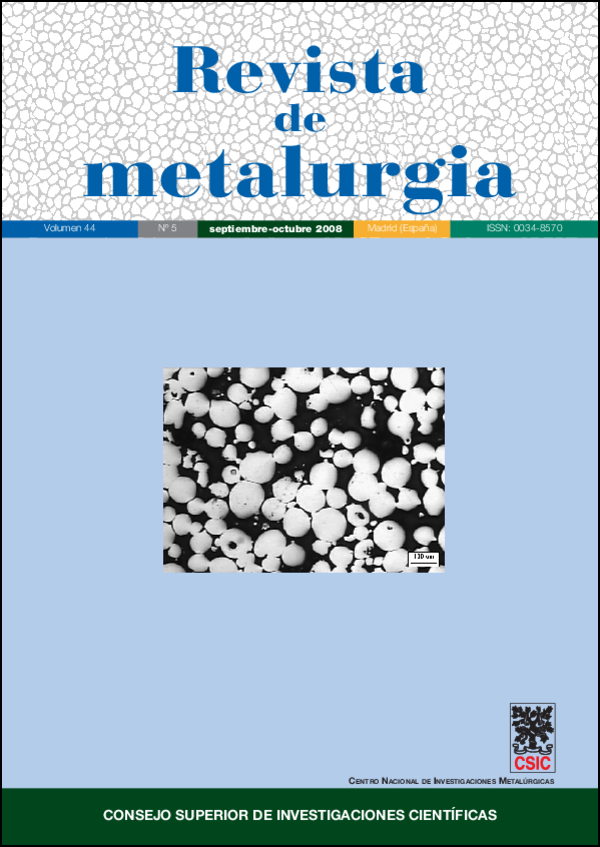The effect of the weld mismatch on the yield load of C(T) and SE(B) fracture specimens
DOI:
https://doi.org/10.3989/revmetalm.0721Keywords:
Mismatch, Common format, Yield loadAbstract
The yield load values of two-dimensional C(T) and SE(B) specimens with various degrees of mismatch, were numerically evaluated. The yield load values were normalized using the Common Format in order to analyze the effect of the weld, using as reference material C(T) and SE(B) specimens made only of base metal (BM). In undermatched specimens (the weld metal elastic limit is lower than that of BM) the normalized yield load decreases compared to the elastic limit of BM. In overmatched specimens (the weld metal elastic limit is larger than that of BM), the yield load increases. This variation of the yield load depends on the degree of mismatch, and on the relation between weld size and crack length. The numerical results were compared with experimental values obtained with mismatched weld C(T) specimens using an ASTM A 588 steel as base metal.
Downloads
References
[1] J.R. Donoso, A. Ortiz y F. Labbé, Rev. Metal. Madrid 39 (2003) 357-366.
[2] R. Leiva, J.R. Donoso, U. Muehlich y F. Labbé, Rev. Metal. Madrid 40 (2004) 3-12.
[3] J. Joch, R.A. Ainsworth y T.H. Hyde, Fatigue Fract. Eng. Mater. Struct. 1993 (16) 1.061-1.079.
[4] M.C. Burstow y R.A. Ainsworth, Fatigue Fract. Eng. Mater. Struct. 1995 (18) 221-234.
[5] M.C. Burstow, I.C. Howard y R.A. Ainsworth, Int. J. Fracture 89 (1998) 117-142. doi:10.1023/A:1007480827982
[6] A.S. Kim, J. Besson, y A. Pineau, Int. J. Solids Struct. 36 (1999) 1.845-1.864.
[7] N.P. O’Dowd y C.F. Shih, J. Mech Phys. Solids 40 (1992) 939-963. doi:10.1016/0022-5096(92)90057-9
[8] O. Ranestad, Z.L. Zhang y C. Thaulow, Int. J. Frac ture 88 (1997) 315-333.
[9] C. Thaulow, Z.L. Zhang, O. Ranestad y M. Hauge, Fatigue and Fracture Mechanics 30, ASTM STP 1360, P. Paris y K. Jerina (Eds.), 2000, pp. 102-114. doi:10.1520/STP13398S
[10] K.H. Schwalbe, U. Zerbst, Y.J. Kim, W. Brocks, A. Cornec y H. Amstutz, EFAM ETM 97, GKSS Research Centre, GKSS/98/E/6, Alemania, 1997.
[11] Y.J. Kim y K.H. Schwalbe, Eng. Fract. Mech. 2001 (68) 1.137-1.151.
[12] J.R. Donoso y J.D. Landes, Eng. Fract. Mech. 1994 (47) 619-628. doi:10.1016/0013-7944(94)90153-8
[13] J.R. Donoso y J.D. Landes, Fatigue and Fracture Mechanics 30, ASTM STP 1360, P. Paris y K. Jerina (Eds.), 2000, pp. 34-50. doi:10.1520/STP13393S
[14] Hibbit, Karlson & Sorensen, Inc., 2000. ABAQUS Manuals, version 6.1.
[15] U. Muehlich, J.R. Donoso y J.D. Landes, Int. J.Fracture 133 (2005) 371-388. doi:10.1007/s10704-005-5825-3
[16] J.R. Donoso, J. Zahr y J.D. Landes, Fatigue and Fracture Mechanics 34, ASTM STP 1461, S.R. Daniewicz, J.C. Newman y K-H Schwalbe (Eds.), 2005, pp. 323-339.
[17] J.R. Donoso, J. Zahr y J.D. Landes, Rev. Metal. Madrid 41 (2005) 401-480.
Downloads
Published
How to Cite
Issue
Section
License
Copyright (c) 2008 Consejo Superior de Investigaciones Científicas (CSIC)

This work is licensed under a Creative Commons Attribution 4.0 International License.
© CSIC. Manuscripts published in both the printed and online versions of this Journal are the property of Consejo Superior de Investigaciones Científicas, and quoting this source is a requirement for any partial or full reproduction.
All contents of this electronic edition, except where otherwise noted, are distributed under a “Creative Commons Attribution 4.0 International” (CC BY 4.0) License. You may read the basic information and the legal text of the license. The indication of the CC BY 4.0 License must be expressly stated in this way when necessary.
Self-archiving in repositories, personal webpages or similar, of any version other than the published by the Editor, is not allowed.
















